Walking along the beach is a favorite activity for many of us. Whether you’ve sought out shells on purpose or stumbled across them by chance on the beach. It’s always a fun surprise when you discover that you have a lovely seashell just waiting for you.
This is the place to be if you’ve ever been curious about seashells or want to learn more about conchology.
We look into how seashells are classified and describe the different sorts of shells in this article. After that, we’ll take a look at some of the individual shells that make up the major families and see if you can find some of your favorite shells listed there.
How to Group The Different Types of Seashells
Shells are not classified or categorized based on their own characteristics. Instead, scientists devised a method to identify the sorts of creatures that would be typical in the shell. There are seven primary classes that they’ve separated them into. As more research is done on these members, some of the members of these classes change and rearrange.
The following are the seven main animal groups that live in shells:
- Gastropoda
- Bivalvia
- Scaphopoda
- Aplacophora
- Monoplacophora
- Cephalopoda
- Polyplacophora
The most frequent shells recovered on beaches are gastropods and bivalves. Of the two, bivalves are the more common. The several sorts of shells you might find in these groups are the focus of this article.
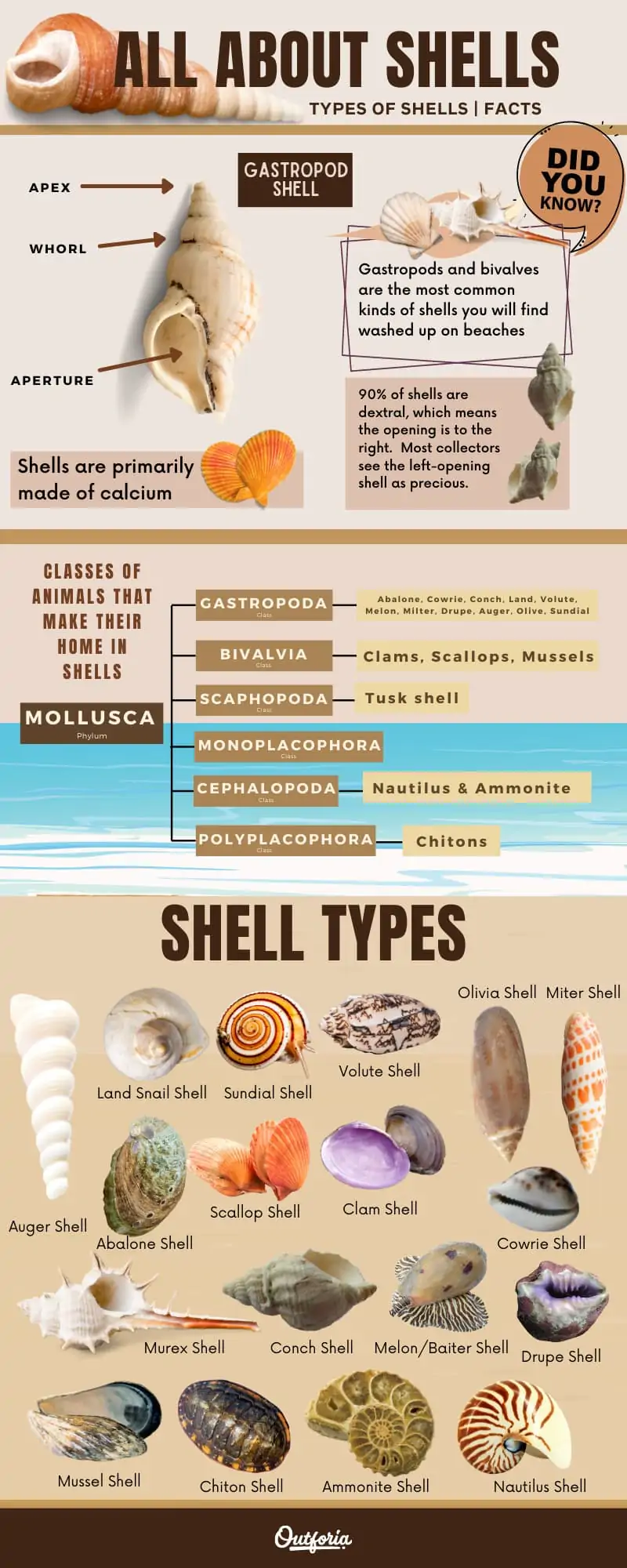
There are over 15,000 species in the bivalve group alone. The other kinds of seashells are more unusual or have fewer species that occupy them. Since these creatures no longer have shells, we won’t discuss them in the Aplacophora. The group’s survivors had been extinct for a long time.
We do not follow the conventional scientific categorization system for the creatures that dwell inside the shells, but we do divide them into seven primary groups. Rather, we look at several of the most prevalent shell types and their subtypes. There is no scientific categorization for shells. Some conchologists, though, may disagree.
Conchology
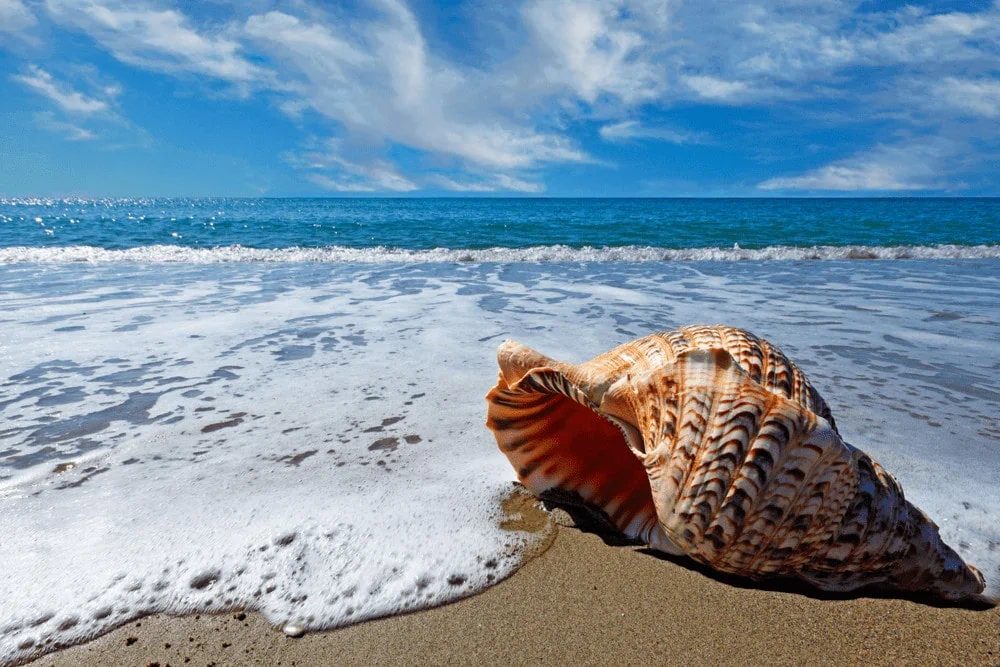
The scientific study and collection of seashells, particularly mollusk shells, is known as conchology. These are the individuals who are willing to pay a premium for unusual or difficult-to-find shells. They don’t overharvest, and they harvest nothing alive. They may occasionally acquire live, shelled animals in their collections, but they make an effort to take good care of them.
People employ a variety of nasty techniques when collecting shells, so be aware. It’s possible to take away the homes of other creatures if you don’t know better.
Hermit crabs, for example, are unable to manufacture their shell. Instead, they discover a new, somewhat bigger shell to call their own when they’re ready to molt. You are effectively ridding them of future houses if you walk the beach and shallows, taking all of the wide-opening medium-sized shells.
For anyone interested in conchology or who already has a small ongoing shell collection, here is a guide to ethical shelling. Being aware of these situations is preferable to damaging the beautiful environment around you.
Knowing what kinds of shells you collect is another educational tidbit that may aid your collection. We’ll look at several of the shells that washed ashore and a few that are extremely uncommon below.
The Seven Types of Seashells
1.0 Gastropoda
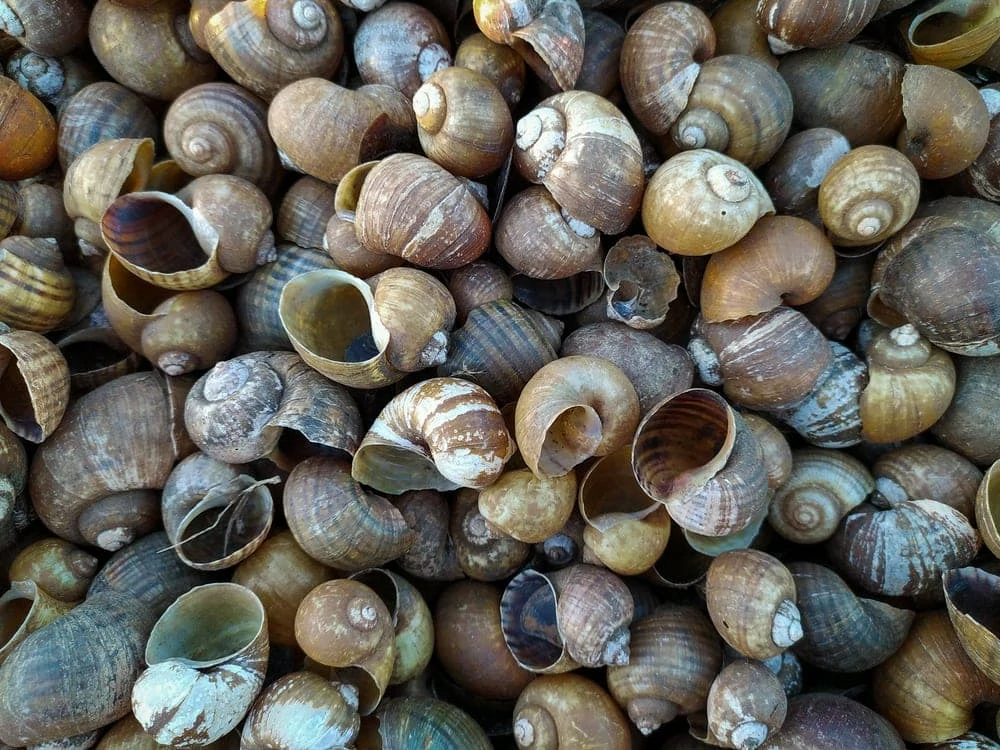
A snail, a kind of mollusk, lived in an empty gastropod shell at one time. Many people don’t realize that the shells were originally part of the snail’s body. Their exoskeleton was made of shell. Consider the toughness of a beetle’s shell. Similarly, a gastropod shell functions.
During their lives, snail species produce the shells. By retracting their body, they may conceal inside. Some, on the other hand, are unable to penetrate fully and are left more vulnerable as a result. Predators are kept at bay by the gastropod’s shell. It also protects them from dehydration and holds calcium, as well as acting as a muscle attachment.
If you study shells, you’re participating in conchology, as we’ve previously said. That is further simplified down. Malacology is the study of gastropods, and it is studied exclusively.
Let’s take a quick look at the morphology of a gastropod’s shell, despite the fact that we won’t go into it too much. It is made up of three separate layers. The mantle of the snail secretes them, which hardens with time. The following three layers exist:
- Periostracum is the outermost layer.
- The central layer is known as Tracum.
- The innermost substance is called conchiolin.
The patterns and designs of the Periostracum will be familiar to us all, as they are on a gastropod’s shell. Shell nacre or mother-of-pearl is sometimes used in the inner layer. Since it comes into touch with the snail’s body, this layer is incredibly smooth.
You may use a variety of morphological words to breakdown the remainder of the shell. Depending on the subject you choose, they may change as well. It’s helpful to understand the following before reading this article:
- Whorl: On the pointed end of the shell, there is a spiral pattern.
- The apex of the whorl is called Apex.
- The shell’s aperture is what we call it.
Let’s take a closer look now that you’re equipped with your tool belt of terms! The majority of gastropods, as well as a few of their associated species, are outlined below.
1.1 Abalone

On beaches all around the globe, abalone shells are one of the most frequent gastropods. Ormers or sea ears are two different names for the same thing.
A spiral whorl is a common appearance of these shells. Since they naturally have holes that run along a single side, they’re especially popular among jewelry collectors. They utilize these apertures for respiration since they have species dwelling inside them. The edge of the shell is drawn in seawater, and the water exits via the apertures as it flows via the shell.
A spiral whorl is frequently seen in these shells. Because they naturally have holes running along a single side, they’re particularly popular among jewelry collectors. They utilize these apertures for respiration since they have species living inside them. Then, the seawater passes via the shell via the apertures after being pulled along by the shell’s edge.
All across the globe, these shells have a fascinating cultural history. Native Americans in North America are one example of this. These were traditionally utilized as beads and money.
The typical name for abalone races is derived primarily from their color. You may encounter the following species:
- Haliotis fulgens green abalone
- Haliotis rufescens, also known as Red Abalone,
- Haliotis sorenseni, white abalone
- Haliotis iris Paua Abalone
- Haliotis corrugata, also known as the Pink Abalone
1.2 Cowrie

Sea snails live in the shells of cowrie, from huge to little. The Cypraeidae family includes all of these marine gastropod mollusks. Cowrie seashells come in over 200 different varieties and species, so they’re common in their natural seas.
These shells can be found on beaches in the Indian Ocean, such as the Maldive Islands, Sri Lanka, and Borneo, because all cowrie snails live in warm seas. Cowrie shells were used as money across East Asia, South Asia, and Africa because they were so prolific in these regions. Because they are so frequently used for jewelry, they are still referred to as “shell money.”
The colors and patterns of cowry shells are stunning. The teeth run the entire length of the shell and line their lips. Around the rounded oval surface, the top of the shell is glossy. This class of shells includes the following:
- Cypraea vitellus, also known as Deer Cowrie
- Cypraea tigris is the scientific name for Tiger Cowrie.
- Cypraea annulus is a purple-colored top cowrie.
- Cypraea moneta Money Cowrie
- Ovula ovum are egg shells.
1.3 Land snail

In humid places or beside the shells of bodies of water, land snails may be scarce in the sea. They’re often despised by farmers and are common garden pests. Land snails can quickly destroy entire crops, but this happens rarely.
A typical gastropod shell is found among the land snails. They have the majority of gastropod characteristics that are morphological. The physical body of the land snail is unlike that of other gastropods. Their usual bodies, on the other hand, aren’t a concern for us.
The eggs of land snails already have a tiny shell. As the snail grows older, these shells expand quickly and spiral out. Only a nickel in size, most land snails will only grow to this size. Yet, some have been known to grow as large as a human skull.
The food chain’s bottom dwells on land snails. Various animals, including humans, are after them. Snails, also known as “escargots,” are often served as a delicacy.
The shells of most land snails are almost identical. They’re generally brown to black in hue, with just a few exceptions. They are not often collected because they are so common all over the globe. The following are some of the species and shell types available:
- Cantareus apertus, the Mediterranean Green Snail
- Cepaea hortensis is a white-lipped snail.
- Cornu aspersum is the scientific name for Garden Snail.
- Otala lactea, or Milk Snail
- Helix pomatia is the scientific name for a Roman snail.
1.4 Conch Shell

The shells of land snails aren’t as well-known as their behavior. The conch shell, on the other hand, favors the opposite. Conches are recognized for their beauty rather than the creatures that may have called them home. They have a variety of cultural and historical significance.
A variety of medium and large-sized sea snail shells are referred to as “conch” in the trade. Compared to other species we cover on this list, the majority of them are fairly significant. A conch shell is defined as one with a high spiral and a fluted aperture, for example.
The queen conch is the most prevalent conch shell found on beaches in North America. Warm seas off the coasts of the Gulf of Mexico and the Caribbean are home to these. They are prized for their edible qualities and as fish bait when they still have occupying snails.
Without being a conch shell, many shells may appear to be the same. They could be more loosely connected as well. The Strombidae family is often mentioned in conjunction with true conches. The Queen Conch (Lobatus gigas) and the Dog Conch (Laevistrombus canarium) are two conches that fall under this heading.
While they are not closely affiliated to the Strombidae family, some other species are also referred to as conch. Melongenidae, Fasciolariidae, and Turbinellidae are among the families represented.
CULTURAL VALUE
The shell’s superior strength is responsible for most of the cultural beliefs connected with conch shells. They’re not as fragile as some of the other gastropod shells. As a result, they can be played as a musical instrument and used as décor.
Conch meat raw in salads or cooked as part of a soup, or even served as a burger, is one of the first things you’ll eat. It is possible to eat each part of the conch. As a result, if you happen across one of these creatures while exploring a deserted island, feel free to dig in.
1.5 Murex
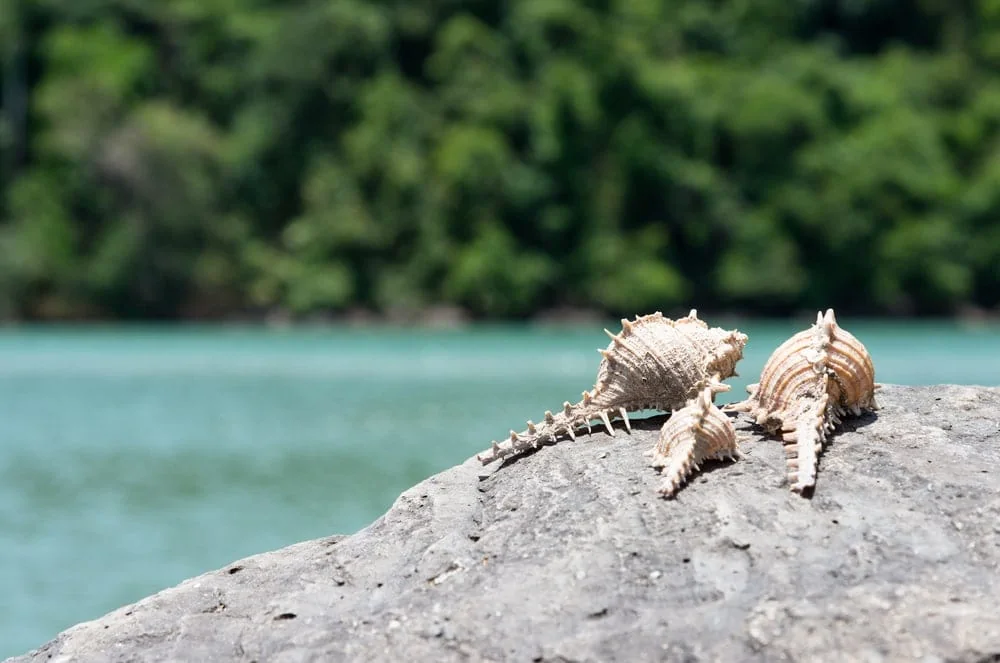
The Murex seashells are immediately recognizable. They have a one-of-a-kind shape and orientation. As a result, they are highly collectable all around the globe. Their colors are obvious, but their forms compensate for this. As a consequence, they are likely to have items like:
- Frondose spines
- Lacy frills
- Webbed wings
- Knobby whorls
They have a larger range than some of the other species on this list, despite not being as popular. Another sea snail is the murex genus. The size of their shells reflects the fact that they are medium to big-sized.
These predatory sea snails live in the ocean. These are mostly found in the tropics, though they may be found in the Arctic. Some mollusks, particularly those found in mudflats, are eaten by them.
The following murex species and shells are examples:
- Siratus Alabaster (Murex Alabaster)
- Regal Murex (Phyllonotus regius)
- Chicoreus ramosus (Murex Ramosus)
- Murex Haustellum (Murex haustellum)
- Murex scolopax (Woodcock)
- Endiva Spine Murex (Chicoreus cichoreum)
1.6 Volute

Another kind of attractive seashell is the volute. It’s a sea snail that’s in the middle of the size range. In tropical seas, they prefer to dwell in muddy or sandy bottoms in deep waters. They’re carnivorous and come in more than 200 different species.
The word voluta means spiraling or curving in Latin. A spiral vase shell with a fairly large opening aperture is found on them. A bright nub can be found at the top or tip of the shell. These are also known as melon shells and bailer shells because of the water holding capacity of their shell.
Species of volute seashells include:
- Noble Volute (Cymbiola nobilis)
- Philippine Melon (Melo diadema)
- Imperial Volute (Cymbiola imperialis)
- Volute Lapponica (Harpulina lapponica)
1.7 Melon Shell
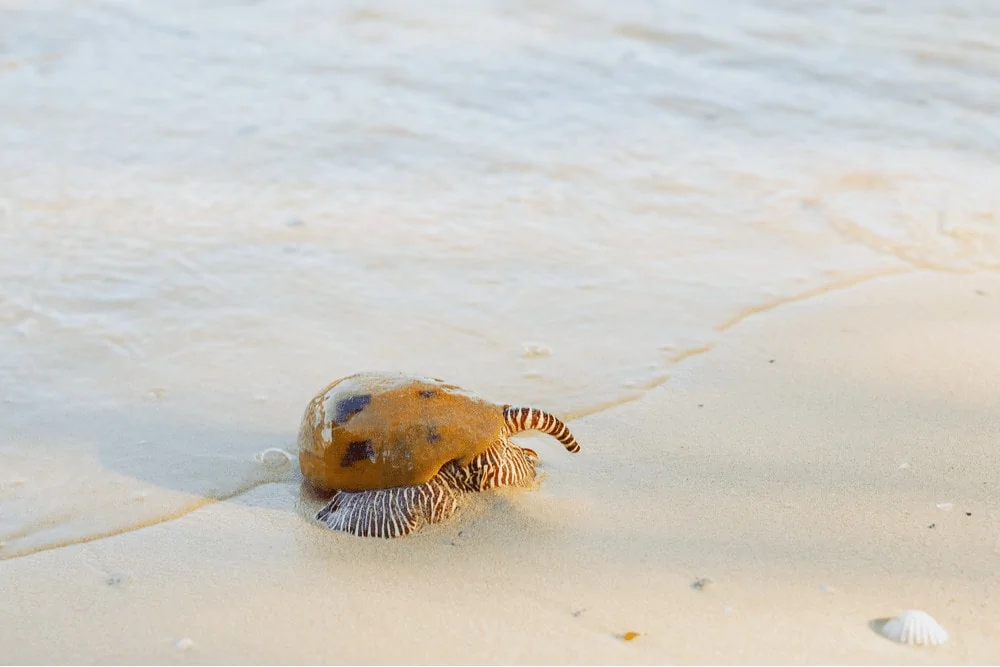
Melon shells are part of the sea snail family, which includes some extremely huge species. From certain angles, they have a very spherical shape that looks like a melon. This name comes from their peachy-orange coloration.
These are also known as Bailer shells because of their large aperture. They’re supposed to be so gigantic, with a huge mouth that allows you to gather a lot of water. These melon shells were used by early sailors to bail unwanted water from inside their boats. Ethiopian Volutes is the name they went by at the end.
These species can produce enormous pearls at times, despite the fact that we wouldn’t normally associate a gastropod with it. For this ability, the most frequent species is Melo melo. The Indian Ocean is home to the majority of these species.
Because the species dwell in deep water, finding many of these shells is more difficult. They’ll only wash ashore on rare occasions. These shells are most frequently discovered through diving. Some of the species that go along with it are:
- Crowned bailer
- Giant bailer
- Southern or Milton’s Bailer (Melo miltonis)
- Umbilicate Melon (Melo umbilicatus)
1.8 Miter Shell

Miter shells come in a variety of colors and are found in tropical seas. Because of their unusual form, they are highly sought after by collectors. They come in a variety of dazzling hues and patterns, including spotted and lined designs.
The columella of these shells is thin and pointed, and the aperture is small. The Indo-Pacific region’s tropical areas are home to the majority of these shells. These are very easy to find in the intertidal zones. The occupying species prefers to dwell and hunt in coral and sandy habitats while they are still alive. They’re generally discovered beneath stones or buried in the sand.
The shell’s form gave it the names “Miter” or “Mitre.” It resembles a bishop’s miter, and it even has a hat on. Other species that live in miter shells include the Mitra mitra, which is sometimes known as the Episcopal Miter.
The shape of the shell gave it the names “Miter” or “Mitre.” It looks like a bishop’s mitre. The name Mitra mitra (also known as the Episcopal Miter) refers to a species that lives in miter shells:
- Mitro papalis
- Mitra taeniatum
1.9 Drupe
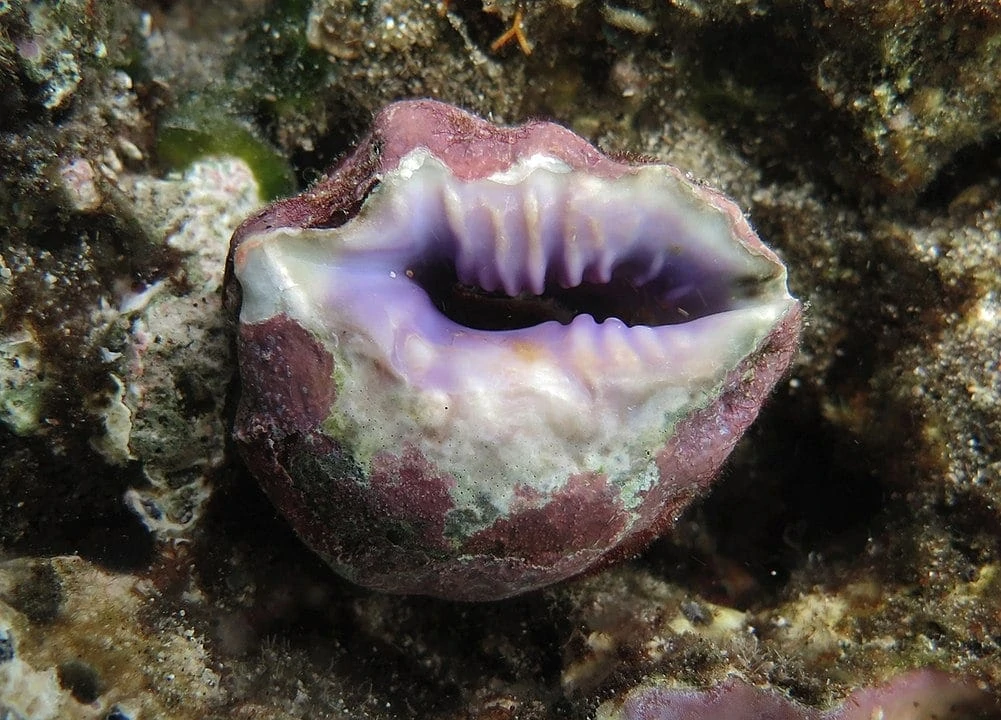
Drupes are large-body whorls found in thick seashells. Nodules, which are bumps on each of their whorls, cover each one. This adds an intriguing aspect to them. Apart from that, the colorful patterns and aperture colors of these shells make them highly sought-after.
A drupe shell has serrated edges on the interior of its aperture. It’s also pretty, with a lavender purple hue, peach, or pink. Their nodules are frequently colored black or brown, and they are usually dark in color.
Muricidae are the family of species that live in Drupe-type shells. They’re carnivorous little sea snails. Little invertebrates are their main source of food. These live in the East Indian Ocean, as do many other species of sea snails. They aren’t particularly uncommon since they live on the coast. Tourists, on the other hand, continue to admire and value them.
You should seek among the intertidal reefs and rocks if you’re looking for these shells in the water. When inhabited by living species, they are also referred to as rock snails. The following shells and species are examples:
- Drupa morum is the scientific name for this purple drupe shell.
- Pink Drupe Shell
1.10 Auger
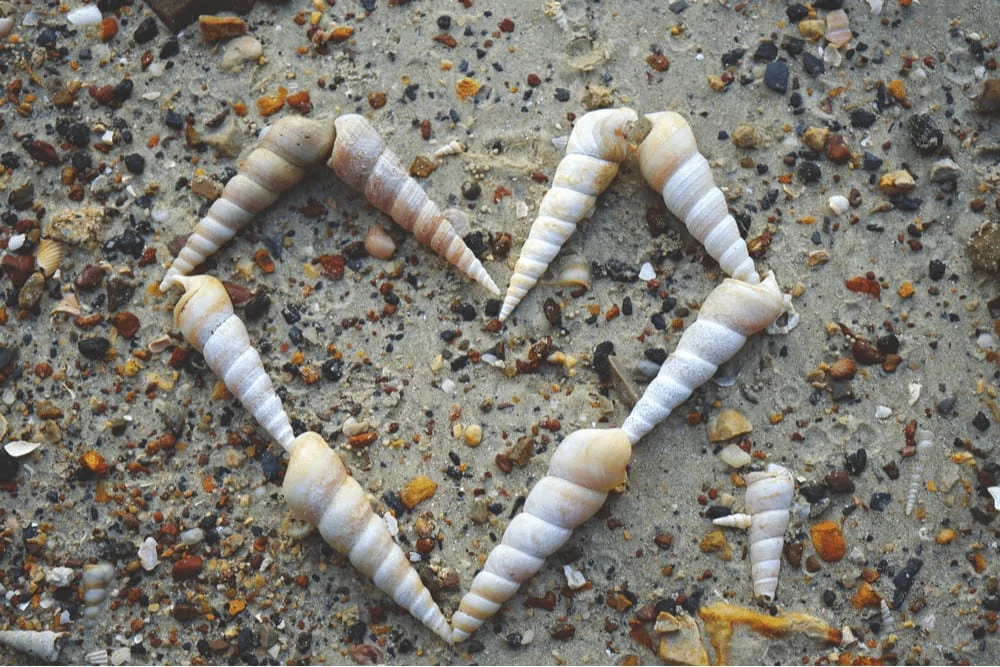
Auger shells are home to the snails of auger. Terebridae family is where the species originates. These predatory marine gastropods range in size from little to huge. The high spire of a whorl is the easiest way to identify these kinds of shells. It gives them the appearance of a drill bit.
There are approximately 400 species identified across the globe. Snails prefer sandy environments and dwell in warm seas. They have a unique hunting style. They have a poisonous barb, which they use to bite people. These are used to paralyze and surprise their prey. Marine worms are the favorite meal of these snails.
The auger shells come in a variety of hues, including light brown and tan. Nevertheless, there are many species with beautiful and intricate shell decorations. Whorls are more prominent and ridged on several of them. Auger shells are found in the following associated species:
- Terebra salisburyi
- Duplicaria kieneri
- Hastula strigilata, or the auger pirate, is a striper.
- Oxymeris maculata (Marlinspike Auger)(Punctoterebra plumbea)
- Lead-Colored Auger
1.11 Olive Shell

Olive shells are the shells that olive snails use to live in. They belong to the Olividae scientific family. All of these sea snails are predators. Although their names imply that they look like olives, their shells are smooth and elongated.
While they may be lovely and patterned, most of the time these shells feature subdued color hues. Olive snails can be found in subtropical and tropical environments all around the globe. In the ocean’s intertidal and subtidal zones, they dwell in sand.
Burrowing into the sand is how olive snails hunt. Among the sea snail species, they are one of the quickest burrowers. Carrion and bivalves are their sources of food. By producing mucus that turns purple when they are attacked, they protect themselves.
South Carolina’s official shell is these shells. Oliva sayana, the Lettered Olive. This group also includes the following species:
- Felicioliva kaleontina
- Agaronia acuminata, or pointed ancilla, is a species of sea snail.
- Agaronia adamii
- Vullietoliva foxi
1.12 Sundial Shell

The sun is associated with Sundial Shells throughout history. Whorls are present on each of their spirals. The Architectonica genus includes all of the species linked to the shell. They can be found in the East and West coasts of North and South America, as well as the Indo-Pacific.
For a collector, these shells are quite valuable. If there is a live species still in them, you should, nevertheless, be careful not to harvest. According to the Red List, several of these species are at risk or endangered.
These shells don’t have a sundial-like appearance. The name is derived from a peculiar appearance that resembles the sun. Each whorl has intricate patterns and light colors ranging from white to brown.
Several snail species found within these shells include:
- (Architectonica perspectiva)
- Clear SundialArchitectonica gualtierii
- Giant Sundial (Architectonica maxima)
- Partridge Sundial (Architectonica perdix)
2.0 Bivalvia

Bivalves are the most common shell on the planet. They account for a significant amount of the seafood that we consume. Farmers raise them to mass-produce food, and many of them are edible.
The term “bivalve” refers to the shells’ form. Bivalve creatures have two shells that hinge on one side, and the Latin term for them is “bis” meaning “two.” Like a door, they may shut and open their shells at the same time.
Bivalves are found in both freshwater and seawater habitats, and they are all aquatic. They prefer to live on the seabed. Others, on the other hand, have a particularly powerful foot and may harden against rocky surfaces.
Bivalve species have been identified in at least 10,000 different ways. They may dwell in the ocean’s deepest trenches or a forest’s shallow brooks. Some have shapes and designs that are stunning, while others appear to be very similar.
2.1 Clam
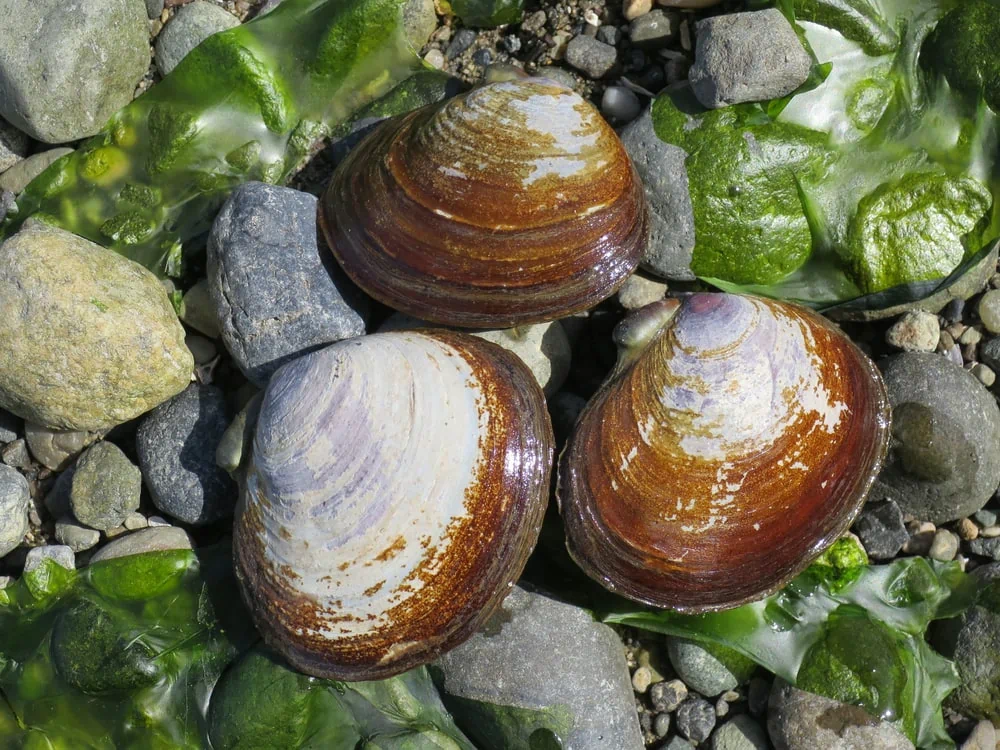
As bivalve mollusks, clams are very common. Clams are a valuable edible commodity, despite the fact that only certain species have shells. They’re also well-known for their ability to squeeze sand for long periods and create pearls. The creation of a pearl by a clam, however, is not as common as it is by an oyster. A pearl of any significant size may only be produced by roughly 1 in 5,000 clams.
Bivalve species that can swim easily include clams, however. Instead, they firmly connect to something or dig down into the sand. In comparison to other bivalves, they have a unique ability: burrowing.
Some of the species of clams include:
- China Clam (Hippopus procellanus)
- Bear Paw Clam (Hippopus hippopus)
- Cardium Heart Shells (Corculum cardissa)
- Small Ark Clams (Arcidae)
- Varnish Clam (Nuttallia obscurata)
2.2 Scallop

Oysters and clams are both scallop seashells. Scallops have the ability to swim, which distinguishes them from other bivalves. They open and shut their shells together while swimming. This process is used to draw water in and expel it as soon as possible. In a zigzag pattern, it shoots them forward quickly.
The majority of scallop species live in the tropics. Yet, several species dwell in polar seas, which is rather intriguing. Another bivalve species trawled and cultivated commercially is scallops, whose edible muscle is also fished and produced.
Scallops come in a variety of bright and fascinating colors.
- Lyropecten nodosa is a species of orange lion’s paw.
- Sunset Scallops (Argopecten gibbus)
- White Florida Bay Scallops (Argopecten irradians)
- Cryptopecten pallium is the scientific name for Pallium Pectin Seashells.
- Patinopecten yessoenisi, Japanese Baking Dish Scallops
2.3 Mussels
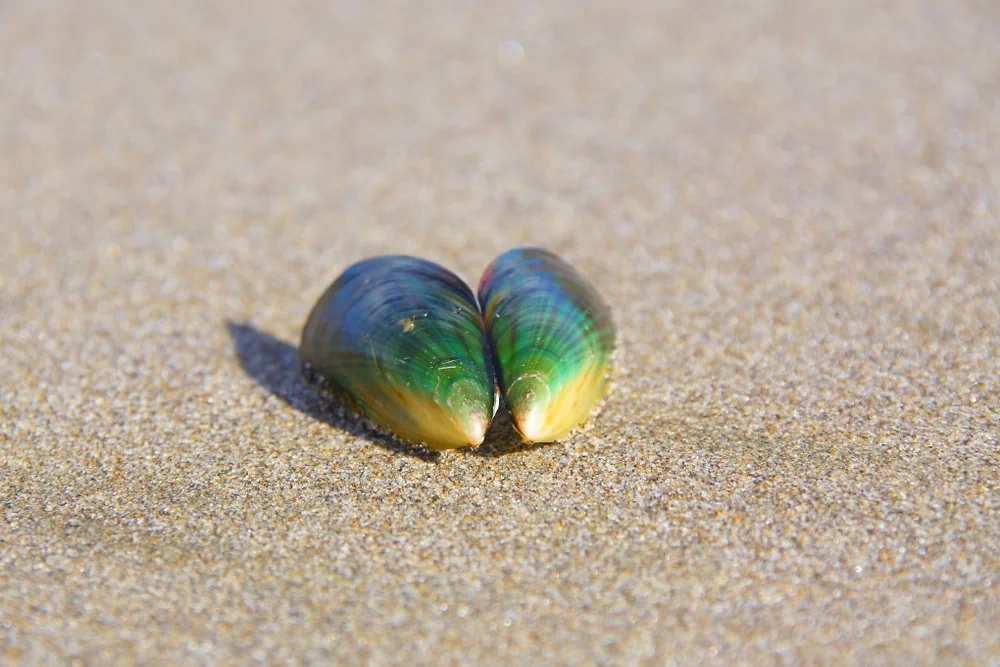
A dynamic ecosystem cannot function without mollusks. Unfortunately, invasive mussels have recently been introduced to native ecosystems, causing damage. Both fresh and saltwater may be home to mussel species. The exteriors are generally dull and dark brown, while the interiors are pearly. They are not collector’s items because most of them are so common.
By attaching themselves to cargo or ships that arrive from the ocean, invasive mussels may enter new areas. They’ve made their way down the Hudson River and are now in the Great Lakes. The natural lake ecosystem is now being devastated by Zebra and quagga mussels.
Other species of mussels include:
- Blue Mussel (Mytilus edulis)
- Perna canaliculus, also known as the New Zealand Green-Lipped Mussel.
- Mytilus galloprovincialis, the Mediterranean Mussel
3.0 Scaphopoda

Scaphopoda shells are rather uncommon. Ancient Greek is the source of the name. Because of their distinctive form, they are also known as tusk shells and tooth shells. They may be translated to mean “boat foot” or “shovel foot.”
These mollusks can be found all over the world. Sediment is home to all of these mollusks. Their shells’ unusual form is due to this reason. Only the very top of the mollusk’s shell protrudes from the sand and sediment offshore.
The fact that these mollusks have openings on both ends of the shell is one of the traits that distinguishes them. As a result, they can dig into the sediment from one end while simultaneously receiving oxygen from the sea through the other.
Some species of Scaphopoda mollusks include:
- Calliodentalium semitracheatum
- Antalis vulgaris, a common tusk shell
4.0 Polyplacophora
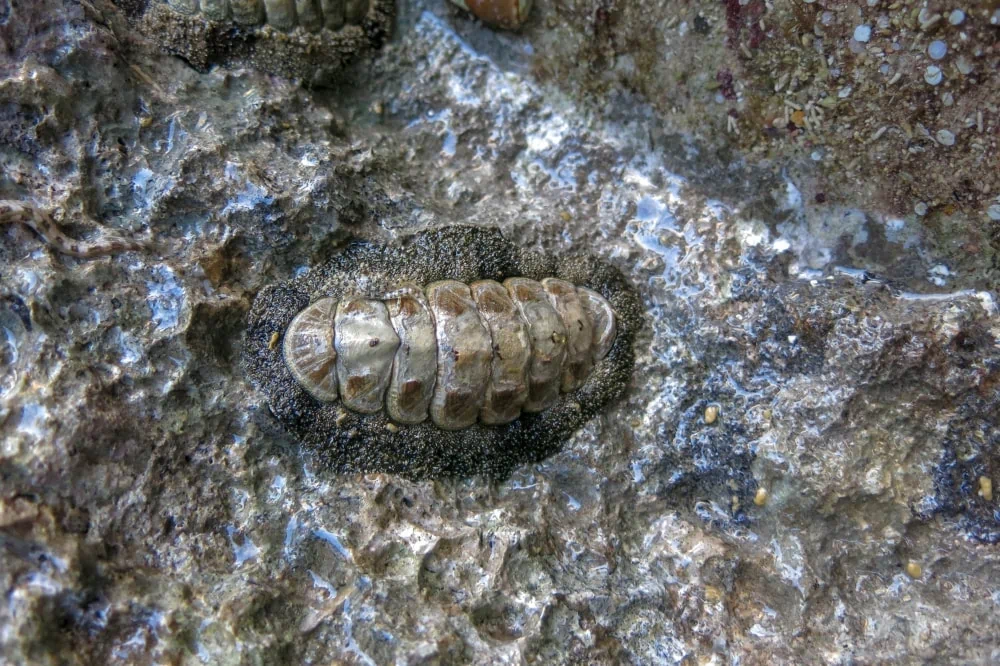
The term “chitons” refers to a group of species that include “Polyplacophora.” They have eight valves that make up their shells, and this is the name given to them by scientists. They seem to be moving on the seafloor like a colorful oval.
Even though they have a worldwide distribution, these lovely mollusks are rather uncommon. The majority of species reside in rocky intertidal zones and shallow tidal areas. Others, however, reside in water more than 22,000 feet (7000 meters) below sea level.
Even though they have a worldwide distribution, these lovely mollusks are somewhat uncommon. The rocky intertidal zones and shallow tidal zones are home to the majority of species. A few, however, live in water that is more than 22,000 feet (7000 meters) deep.
Chitons were formerly thought to be algae or other marine plant species. Their shells are covered in a mossy-looking liner that many of them have. Nonetheless, keeping them safe from predators is a form of camouflage.
The chiton’s shells are quite intricate. Some species have thousands of little bumps scattered over their surface, which can be seen with a close look. The eyes are closed, but they can pick up everything.
Some of the associated species of chitons include:
- Lined Chiton (Tonicella lokii)
- Mossy Chiton (Mopalia muscosa)
5.0 Monoplacophora
It was formerly thought to be extinct, but it is closely related to gastropods. One species has just been discovered in the deepest depths of the ocean. The majority of the remaining species have gone extinct. These creatures can be found as fossils, but to someone unfamiliar with shell identification, they look like gastropods.
They have just one cap-like shell that totally covers the top of their bodies, and their name means “bearing one plate.” They feed beneath the deep-sea pressure by using the bottom to travel along the ocean’s bottom. These gastropods have been poorly studied and are only known to have a shell in fossils.
6.0 Cephalopoda

Cephalopoda species with shells are a tiny minority. Octopuses and squids are two common names for cephalopods. Others, however, make their homes inside shells.
Cephalopod species may vary significantly, but they all have certain traits in common. Tentacles or arms are found on all cephalopods. Backbones are not found in any of them. Their blood is blue, and they are all invertebrates.
You wonder, “Wait?” Why don’t invertebrates have hard exoskeletons? Octopuses and squids are also cephalopods, right? They still matter, and our article on octopuses will tell you why.
6.1 Nautilus

The nautilus is named after the Ancient Greek term “sailor,” which refers to six distinct species that are divided into two genera. The most well-known species is the Chambered Nautilus, which is protected from extinction.
The nautilus has a relatively smooth shell. It has a wide opening and a tight whorl that folds in on itself. These mollusks move forward by expelling their tentacles from the opening and propelling themselves.
Since the nautilus has remained relatively unchanged for millions of years, scientists believe it to be a living fossil.
6.2 Ammonites

The Cephalopoda class of marine mamanimals includes ammonoids, which are now extinct. Their shells are no longer visible on the beaches or at the ocean’s depths as a consequence. Instead, they have been fossilized in the vast majority of cases.
Ammonoid fossil shells are planispheric in shape. As a result, as a fossil, they coil in a tubular manner. The term “fossilized shells” comes from this spiral.
These creatures were extinct even before Pompeii was destroyed. Since the Egyptian deity Ammon was often depicted wearing ram’s horns, Pliny the Elder referred to these fossils as “horns of Ammon” circa 79 AD.
Interesting Facts about Shells

1| The largest known land snail was an African giant snail.
Achatina achatina is the name of the African Giant Snail. In December 1978, the world’s biggest specimen was discovered and measured. From its nose to the end of its tail, it grew to 15.5 inches (39.3 cm). It had a 10.75-inch (27.3-centimeter) shell.
2| Mollusks make their shells using calcium carbonate and protein.
Mollusks secrete calcium carbonate and a variety of proteins from their mantles to form their shells. Almost all mollusks have already developed small shells within their bodies when they are born. Their shell grows in size as they continue to develop. Each day, the animal inside grows and the mollusk shell expands to accommodate it.
3| The majority of shells are dextral or right-opening.
Almost 90% of all shells are right-opening or dextral, which is the most common type. Sinistral shells, also known as left-opening shells, are rare because of this. For a typical kind of shell that is sinistral, shell collectors will pay a high price.
These shells are not intended for an evolutionarily satisfying existence, despite their popularity as a collector’s item. Mating is essentially impossible, and their genetics are not passed down.
4| Jeanne Power invented the aquarium in 1832 to study the argonauts and their shells.
In 19th-century France, Jeanne Villepreux-Power worked as a seamstress. She is mostly unknown to history, although her cephalopod studies and dressmaking abilities are now recognized. In 1832, she designed the contemporary glass aquarium to conduct research on paper nautilus.
5| In Turks and Caicos, there is a Conch Festival every November.
Every November, the Blue Hills of Turks and Caicos Islands host a Conch Festival. The most creative and delicious conch dishes are submitted by all of the local restauranteurs. International chefs evaluate them once they have cooked and served them all up. There are a variety of musical performances, challenges, and other activities throughout the festival.
6| The shell trade is having a dangerous effect on wild populations of marine animals, and you have likely helped it in the past.
The majority of the shells you acquired on vacation were not gathered randomly from the beach. Instead, since abandoned shells will be in far worse condition than living animals, they are frequently obtained from them. Buying these shells promotes the shell trade. Every year, it risks the lives of tens of thousands of marine animal species.
7| The oldest collection of shells was found in Pompeii.
In the eruption of Mount Vesuvius in Pompeii, the earliest known collection of shells was discovered. They’re estimated to have lived in the year 79 AD. Since several of the shells originate from distant oceans, some as far away as the Red Sea, it was a spectacular collection. The prevailing theory is that they were kept because they were attractive, despite the fact that the collection was extensive.
